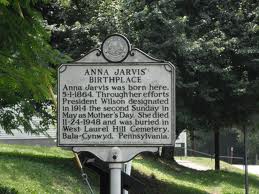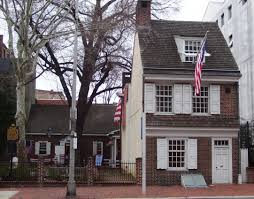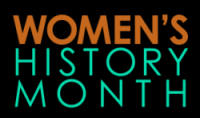 Anna Jarvis House is a historic home located at Webster, Taylor County, West Virginia. It was built in 1854 and is a two-story, frame “I house” plan dwelling. It is notable as the birthplace of Anna Jarvis, founder of Mother’s Day, and as General George B. McClelland’s first field headquarters during his 1861 western Virginia campaign. It was listed on the National Register of Historic Places in 1979. Anna Jarvis House
Anna Jarvis House is a historic home located at Webster, Taylor County, West Virginia. It was built in 1854 and is a two-story, frame “I house” plan dwelling. It is notable as the birthplace of Anna Jarvis, founder of Mother’s Day, and as General George B. McClelland’s first field headquarters during his 1861 western Virginia campaign. It was listed on the National Register of Historic Places in 1979. Anna Jarvis House

Betsy Ross House celebrates the well-known and loved story of Betsy Ross sewing the first Stars & Stripes is tightly woven into the colorful fabric of America’s rich history. The Betsy Ross House, the birthplace of the American flag, is alive with the sights and sounds of the 18th century. Tour the house and then stay a while longer to learn more about Betsy and her exciting life and times through our interactive, historical programming. Betsy Ross House

National Archives At New York City: During the beginning of US involvement in World War II, as factories shifted to wartime production and millions of men were sent overseas to fight in Europe and the Pacific, women of all ages, ethnicities, and marital statuses entered the workforce. While most women were not new to the working world, the specific industries they now began working in were previously occupied by men. With countless “Rosie the Riveters” entering factories, the Office of Education produced the film “Supervising Women Workers” as part of their “Problems in Supervision” series in 1944. This film was created to help male supervisors manage the different behaviors and beliefs of the woman worker. Through discussions between a factory foreman Joe and the plant manager, the film highlights the major differences between male and female workers and how to properly supervise this new type of worker. National Archives
 Women’s History Month had its origins as a national celebration in 1981 when Congress passed Pub. L. 97-28 which authorized and requested the President to proclaim the week beginning March 7, 1982, as “Women’s History Week.” Throughout the next five years, Congress continued to pass joint resolutions designating a week in March as “Women’s History Week.” In 1987 after being petitioned by the National Women’s History Project, Congress passed Pub. L. 100-9 which designated the month of March 1987 as “Women’s History Month.” Between 1988 and 1994, Congress passed additional resolutions requesting and authorizing the President to proclaim March of each year as Women’s History Month. Since 1995, Presidents Clinton, Bush, and Obama have issued a series of annual proclamations designating the month of March as “Women’s History Month.” Women’s History Month
Women’s History Month had its origins as a national celebration in 1981 when Congress passed Pub. L. 97-28 which authorized and requested the President to proclaim the week beginning March 7, 1982, as “Women’s History Week.” Throughout the next five years, Congress continued to pass joint resolutions designating a week in March as “Women’s History Week.” In 1987 after being petitioned by the National Women’s History Project, Congress passed Pub. L. 100-9 which designated the month of March 1987 as “Women’s History Month.” Between 1988 and 1994, Congress passed additional resolutions requesting and authorizing the President to proclaim March of each year as Women’s History Month. Since 1995, Presidents Clinton, Bush, and Obama have issued a series of annual proclamations designating the month of March as “Women’s History Month.” Women’s History Month
 Women’s Rights National Historical Park was established in 1980 and covers a total of 6.83 acres of land in Seneca Falls and nearby Waterloo, New York, USA. The park consists of four major historical properties including the Wesleyan Chapel, the site of the first Women’s Rights Convention. The Elizabeth Cady Stanton House and the homes of other early women’s rights activists (the M’Clintock House and the Richard Hunt House) are also on display. The park includes a visitor center and an education and cultural center housing the Suffrage Press Printshop. Women’s Rights Historical Park
Women’s Rights National Historical Park was established in 1980 and covers a total of 6.83 acres of land in Seneca Falls and nearby Waterloo, New York, USA. The park consists of four major historical properties including the Wesleyan Chapel, the site of the first Women’s Rights Convention. The Elizabeth Cady Stanton House and the homes of other early women’s rights activists (the M’Clintock House and the Richard Hunt House) are also on display. The park includes a visitor center and an education and cultural center housing the Suffrage Press Printshop. Women’s Rights Historical Park